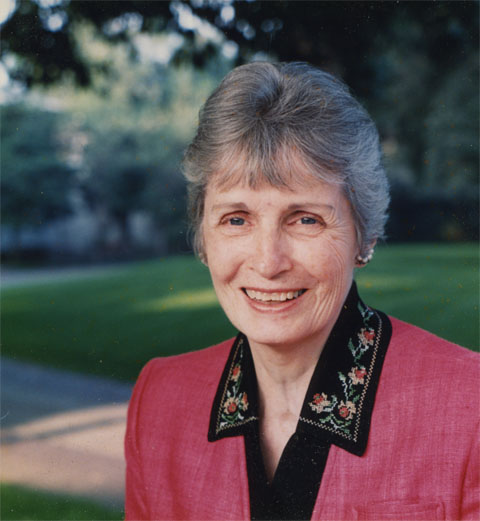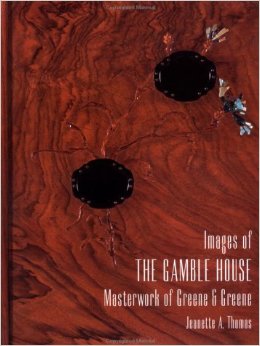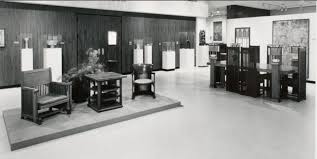OUR STORY THROUGH THEIR EYES: JEANETTE THOMAS Picturing a Legacy That Put The Gamble House in a New Light
By Bobbi Mapstone, Gamble House History Committee

I interviewed Jeanette Thomas on July 6, 2006, while I was on staff as PR and Marketing Manager at The Gamble House. Then, as now, she held a place of honor in Docent Council lore and my oral history experience compelled me to get her story “on the record.”
On interview day, Jeanette was well-prepared but a bit under the weather and the gardeners were making a din. However, she graciously agreed to go ahead.
Born in Greeley, Colorado, Jeanette lived in a Craftsman bungalow until she was five when her family moved into a two-story brick house with strong Craftsman characteristics. She remembered raking autumn leaves with her brother and, before piling them up, creating house floor plans—an unusual activity for young kids and, perhaps, the beginning of her abiding interest in how houses are put together.
In 1946 she married Frank Thomas—one of Walt Disney’s legendary animators known as “the nine old men”—and the couple began to plan a house. Three years later, the completed Thomas home in La Cañada Flintridge was a custom residence designed by USC-trained architect Theodore Criley, Jr.
Marked by textured wood, brick, and glass, the design was heavily influenced by Richard Neutra and Frank Lloyd Wright and was well-ingrained in its environment. Jeanette, an educator with a passion for architecture and an eye for detail (she might have been an architect, she said—if only she could draw), was unknowingly preparing herself for a long stint as a Gamble House Docent.
AN 11-YEAR COURTSHIP
The House lured her in slowly. She read about it opening to the public in 1966 and when she realized the handsome rock-formation gate on Rosemont Avenue led to the House, she knew she needed to visit. It took four years for that visit to happen but the connection was immediate. Another seven years passed before the time was right for her to become a Docent in 1977.
The Docent Training class had a strong academic flavor influenced by then-Director Randell Makinson and Jan Strand, the first President of the Docent Council. (In 1974, Strand had written “A Greene & Greene Guide” and Randell’s “Greene & Greene: Architecture as a Fine Art” appeared the same year Jeanette became a Docent.) New Docents were required to write papers on House-related topics such as built-ins, bungalows, the Greenes, the Gambles, Japanese influences, and more—all of which became part of the archival collection. The intense training ran from October through May on Saturday mornings for three hours and then continued with field trips both locally and to Arts & Crafts locations across the country.
Education was Jeanette’s focus and her favorite activities included leading such committees as Gamble House Register, Ongoing Education, Touring, Junior Docents, and co-chairing Docent Training from 1980-82 with Jo Kehoe. As Inventory Chair from 1978-80, she manually logged and described all the furniture, lamps, and pictures in the House.
Jeanette contributed to and then made several revisions to the room-by-room list of significant items, authored several revisions of the Docent Manual, and wrote the House self-guided-tour brochure. Other projects included written materials for neighborhood Arts & Crafts architecture tours, the Thorsen House exhibition, and monthly articles for the newsletter.
LETTING THE DETAILS SHINE

The large amount of information she acquired made it difficult for her to limit her tours to the designated one hour, but she shared the wealth in “Images of The Gamble House: Masterwork of Greene & Greene,” which she edited. Collaborating with her documentary filmmaker son, Ted Thomas, and his wife, Kuniko Okubo, they would go to the House on Wednesdays, Fridays, and weekends during non-touring hours to photograph the House using available natural light.
When published by The Gamble House/USC in 1989, the new book, with more than 100 images, was the first to emphasize the Greenes’ attention to fine detail. One of her biggest compliments came from Jim Gamble—one of David and Mary’s six grandchildren who arranged the gift of the House to Pasadena and USC. Although not said to her directly, he pointed out a detailed photo taken in the Entry Hall to Randell and said, “Gee, I have never seen that before.” The House is like a splendid symphony: You don’t get it all with one or two visits, or even several.
Admission in 1977 was $2 for the general public and $1 for senior citizens and full-time students, Jeanette recalled. There were no tickets and the tours would end in the modest Bookstore in the Den. One-hour tours were given on Tuesdays and Thursdays. One weekend each year was an open house, but that later expanded to once every month.
Randell insisted that the tours reflect each Docent’s own interests—architecture, interior design, etc.—rather than be a “canned tour.” In another of Jeanette’s early recollections, Jim Gamble wanted to call the House “The Gamble Home.” That, Jeanette confided, sounded like a place for elderly family members or where gamblers live (and, to prove a point, there were visitors who wondered where the slot machines were located).
FAMILY, THEN AS NOW
Jeanette recalls that three of Randell’s secretaries were among the very best Docents: Jane Unruh, Nancy Ullrich, and Betty Ullner. The House had a strong feeling of family that seemed to draw people to become Docents. Many were retired or at an empty-nest phase of life, there were no “working Docents” and only a few with young children. The First Wednesday Luncheons and personal tours were a great opportunity to attract friends who shared an interest in becoming Docents as well as give Docents who liked to cook a chance to do it in the House.
Members of the Gamble family would visit the House and were a great resource for both gathering and correcting Docent information. On occasion, a family member would return a decorative item to the House. Sidney Gamble noticed a bare wall in the Den and said the picture that used to hang there must be returned, and so it was. On the back it reads, “To Sidney, from Mother.” A similar thing happened with the watercolor picture by the entrance to the Dining Room, the seascape with boats.
An active Docent for 22 years, Jeanette said architects were among her favorite visitors as they would return frequently to explore and admire this architectural gem. A gem herself, Jeanette’s contributions were many, and her book a significant legacy.
About Jeanette
Jeanette Thomas joined the celebrated ranks of Honorary Docents in 2005 for her “exceptional enrichment to The Gamble House.” Her many contributions included chairing the Register, Ongoing Education, Touring, Junior Docents, and Inventory committees and co-chairing Docent Training. She edited the still-inspiring “Images of The Gamble House: Masterwork of Greene & Greene” in 1989. Jeanette died in 2012 at age 91.


Leave a Reply